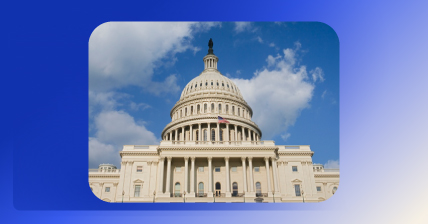The federal government provides a wide array of vital utilities for the public. Because of the importance of government utilities and their role in serving the public, federal agencies must place an emphasis on customer service. Customer Experience (CX) is an essential measurement of feedback for federal agencies and their fulfillment of that role. While an ever-changing political and technological environment creates continuous challenges to serving the public, with proper usage of resources, agencies can maintain and enhance their customer service.
Customer Service as a Positive Experience
Amidst the political tumult and rising inflation during the COVID-19 pandemic, customer experience scores remained consistent in the federal sphere. Across all other industry verticals, the modern challenges led to poor customer experience scores.[1] In a recent survey of 221 brands across 13 industries, CX scores dipped 19% across all brands. However, the federal average remained statistically identical with a positive rating of 62.3%, a feat that Forrester Vice President and Research Director Rick Parrish consider positive amongst the changing national landscape.[2] Modern technology has been an excellent tool for gathering data on customer experience in all fields. Websites like www.va.gov/trust, www.usa.gov, and login.gov, measure CX by gauging customers’ levels of trust in the government, as well as the effectiveness of federal services. This basic strategy can be implemented at any level of government, or within any industry. By enacting these types of services, and properly interpreting user feedback, federal, state, and local agencies can better their services to fulfill public needs.
Agencies should conduct improvement efforts in a way that fits their unique needs. For some, this may be stationing volunteers to greet customers and conduct experience surveys. For others, it may be through online or mail feedback surveys. Agencies should make use of websites like www.va.gov/trust that aim to measure CX. Regardless of the method, it is important to gauge the level of confidence in federal services and to make improvements based on identified weak areas. By considering each organization’s unique workflow and data response, agencies can keep up with customer desires and demands. Generally, however, customers require a human-centered approach, where they can be met on their own level of comfort. By altering services to fulfill demands, agencies can perform at this level of trust with ease and effectiveness.
The Federal Push for Enhanced Customer Service
 The federal government has passed several initiatives that aim to improve customer experience, validating agency efforts to improve their CX scores. One example is the President’s Management Agenda (PMA), a multi-staged, administration-wide effort that focuses on improving customer experience within federal agencies. PMA strategies include hiring a diverse and qualified workforce base and delivering excellent and secure services. Both strategies support optimizing customer care to improve their experience. Another initiative is the Technology Modernization Fund (TMF), a government action plan that seeks to enhance customer experience through cybersecurity. The TMF funding will strengthen data security, zero trust architecture, Secure Access Service Edge, Security Orchestration, Automation, and Response technologies. These will enhance website safety, allowing more utilities to be provided to the public online. This will speed line and simplify government services for busy customers that are on the go. By accelerating security improvements, the TMF elevates government services and websites to better support the public.
The federal government has passed several initiatives that aim to improve customer experience, validating agency efforts to improve their CX scores. One example is the President’s Management Agenda (PMA), a multi-staged, administration-wide effort that focuses on improving customer experience within federal agencies. PMA strategies include hiring a diverse and qualified workforce base and delivering excellent and secure services. Both strategies support optimizing customer care to improve their experience. Another initiative is the Technology Modernization Fund (TMF), a government action plan that seeks to enhance customer experience through cybersecurity. The TMF funding will strengthen data security, zero trust architecture, Secure Access Service Edge, Security Orchestration, Automation, and Response technologies. These will enhance website safety, allowing more utilities to be provided to the public online. This will speed line and simplify government services for busy customers that are on the go. By accelerating security improvements, the TMF elevates government services and websites to better support the public.
State & Local Customer Experience
One vital part of maintaining pace with CX needs is surveying customers to discover which areas require altering. Ultimately, if government services are not meeting customer needs, then the federal government is not fulfilling its duty to the public. For example, a Phoenix, Arizona VA Medical Center Office of Inspector General report revealed that veterans were not satisfied with the center’s services, as many were unable to access the care they needed in a timely manner. As a result of the survey, attention was brought to the fact that the system needed to be improved. This case study demonstrates the importance of ensuring that agencies have positive CX scores, as their functionality will otherwise be limited. By elevating CX measures and focusing on performance efforts, Phoenix Medical Center was eventually able to bring customer confidence scores up from 55% to 78%. Agencies can better serve the public and fulfill their role by making the customer experience a co-equal measure of their effectiveness.
Realignment Toward Improved Customer Service
Through surveys and government initiatives, federal agencies must restructure their business model to emphasize customer experience. By receiving and implementing feedback, agencies can enhance their services to better serve the public and fulfill their promise to be by and for the American people.
View the Government Customer Experience and Engagement Summit sessions to learn more about interpreting customer data and implementing modern technology to enhance agency customer service.
[1] “The US Customer Experience Index Rankings, 2022,” Forrester, https://www.forrester.com/report/the-us-customer-experience-index-rankings-2022/RES177585?ref_search=0_1655322144917&elqTrackId=4AB1B28A548DD78AFCDA2CA0180F4BAC&elqTrack=false&elq=e573db790b754d6fbfd75cc359c0add6&elqaid=134324&elqat=1&elqCampaignId=20620
[2] “Report: Government Customer Experience Scores Held Steady Despite Declines in Most Industries,” Next Gov, https://www.nextgov.com/technology-news/2022/07/report-government-customer-experience-scores-held-steady-despite-declines-most-industries/368888/






